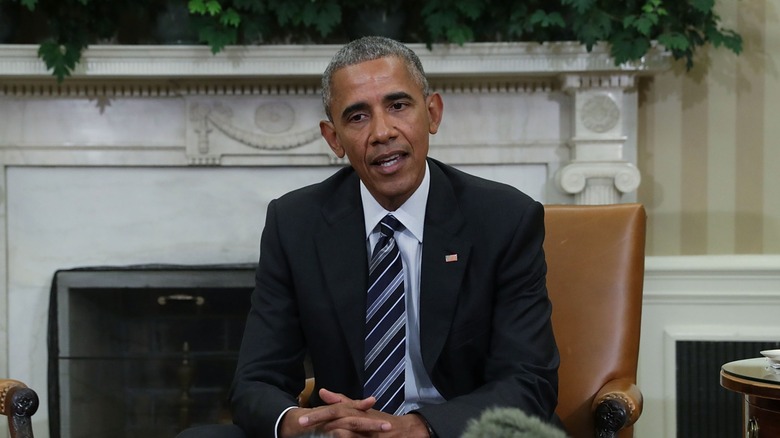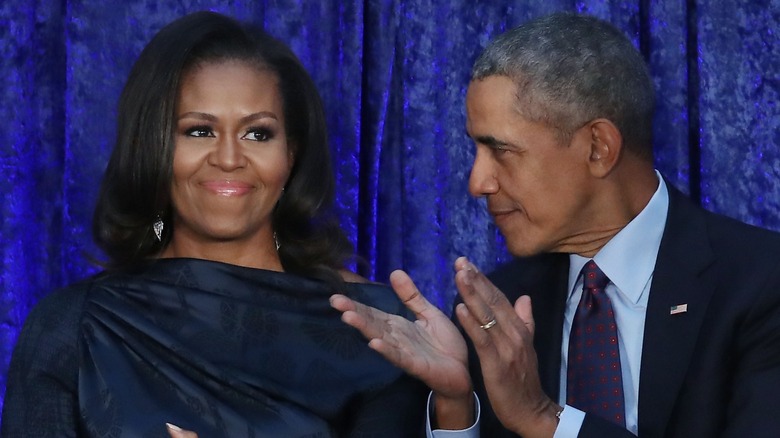What It Was Really Like For White House Decorator Michael Smith To Work With The Obamas
When you think about White House decor, something that often comes to mind is the holidays — like when the 2021 White House Christmas decorations had X, formerly known as Twitter, in a tizzy. But decorating the presidential residence goes far beyond seasonal work. White House decorator Michael S. Smith opened up about working with Former President Barack Obama and Former First Lady Michelle Obama and confirmed it was an overwhelmingly positive experience.
Smith was the interior decorator (or "decorator in chief") for all eight years of the Obamas' tenure. He even co-wrote a book about that time entitled "Designing History: The Extraordinary Art & Style of the Obama White House." Smith first arrived at the country's most famous house on the day of Barack's 2009 inauguration, telling CNN: "You're given all sorts of research material [...] You have photos and diagrams, but you don't really know what's going on in the rooms until you show up." The interior designer also mentioned that the rooms on the upper levels of the White House were taller than he expected.
Smith noted that remnants of the former presidents could be seen as he worked on the project, something Barack and Michelle were mindful of. "Being so incredibly interested in history in general, I think they were unbelievably respectful of what existed before," he acknowledged. "They were so thoughtful and so appreciative of the fact that this wasn't their house, it was the country's house — America's house."
Some of the Obamas' furniture was from everyday brands
Decorators for the White House usually donate their time and work. Due to the economic crisis at the time Barack Obama became president, everyone was cautious about overspending. Barack used money earned from his book to pay for furniture, and some was donated. Other pieces came from the White House collection, and museums lent out artwork. In an interview with Town & Country magazine, Michael S. Smith talked more about budgetary constraints, sharing, "There was a mandate to do everything inexpensively."
Some of the furniture in various rooms during Barack's two terms were from brands like Crate & Barrel, Anthropologie, Pottery Barn, and even Walmart. Older pieces were mixed with new ones. Barack and Michelle Obama were well aware that they wouldn't live at 1600 Pennsylvania Avenue forever. "Everything was always met with this question of, 'How will this be for the next family?'" Smith told CNN.
Barack and Michelle's marriage changed after leaving the White House, but much of the furniture around them was the same. Another benefit of paying for their own stuff was that they could use it afterward. Smith knows that they did exactly that since he decorated the couple's house post-presidency too.
Michelle wanted to include new art in the White House
When Michael S. Smith redecorated the Oval Office, some people criticized his design for its predominantly neutral tones. According to The New York Times, certain critics pointed out how it seemed less relaxed and more all-business than before. However, as Smith reasoned, "That was very much the idea, right? He was in the office all the time. And I think that I wanted it to be as peaceful and comfortable as it could be." Likewise, in The Washington Post, the interior decorator described his Oval Office as "a no-drama room for a no-drama president."
Not only did Michelle Obama make a major fashion change for White House staff but she also wanted to add more modern art to the space in addition to some of the iconic pieces already featured there. They brought in artwork by many Black artists with Smith explaining to CNN, "The idea was to make up for lost time. You basically had 75 years of American art history and cultural history to bring the building up to (speed with)."
The "decorator in chief" has shared several photos on Instagram of his impressive White House handiwork. In one instance, Smith posted a shot of a living room that included some new art. A piece by Glenn Ligon could be seen on the wall, and the artist himself commented: "My painting on the right. Those were the days."


